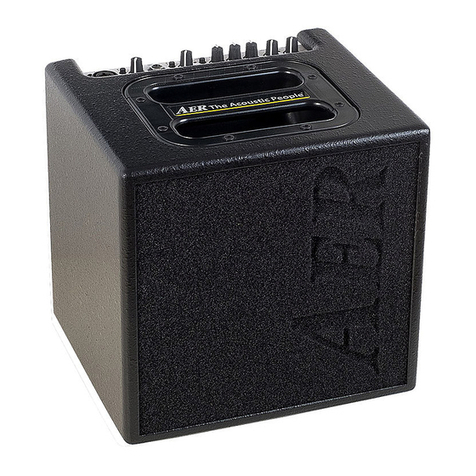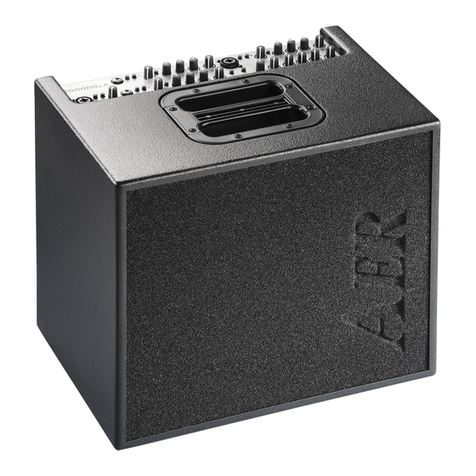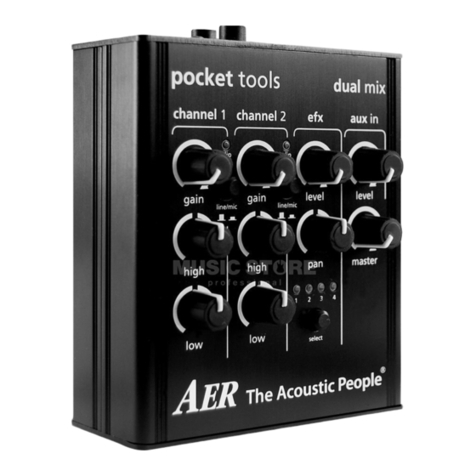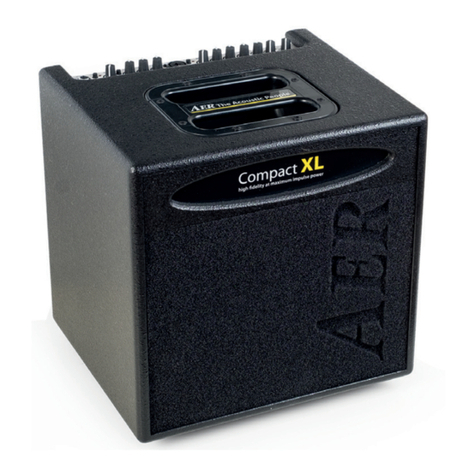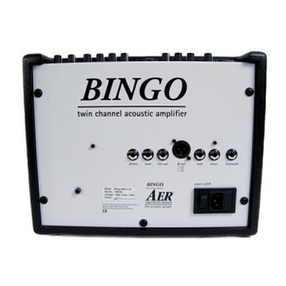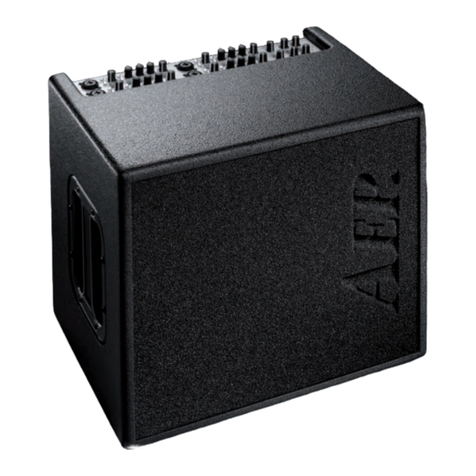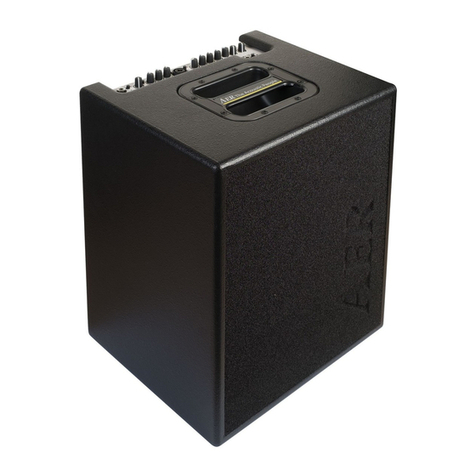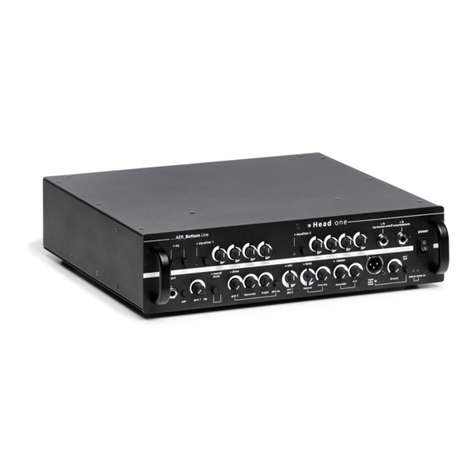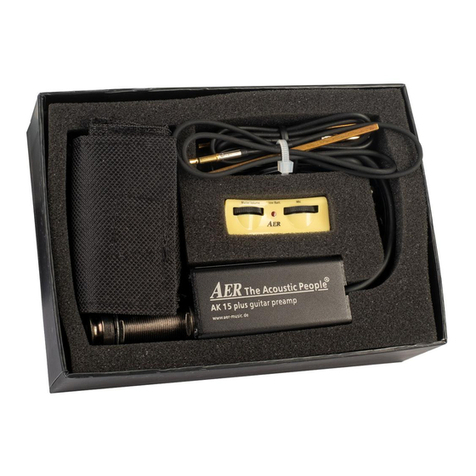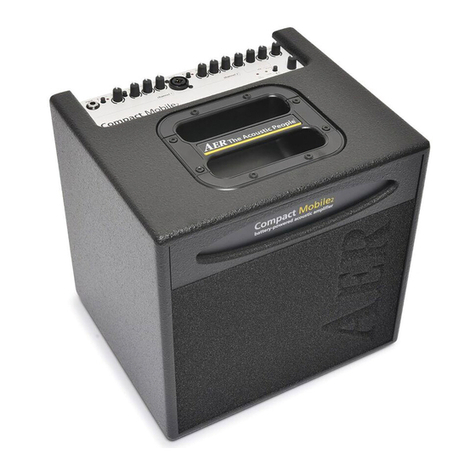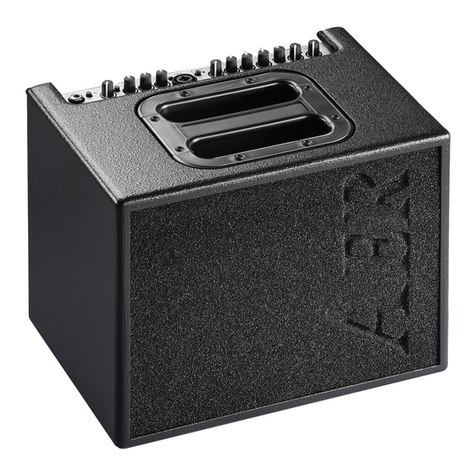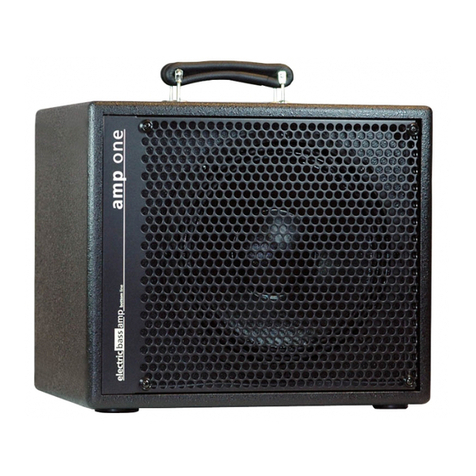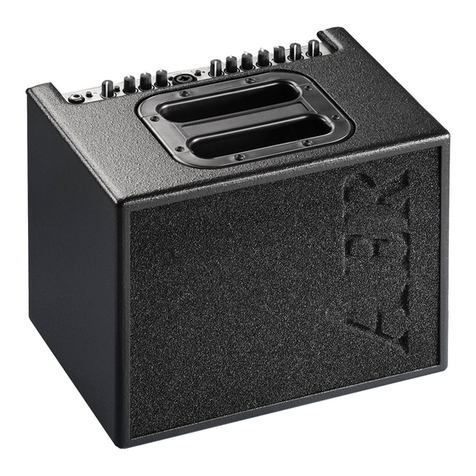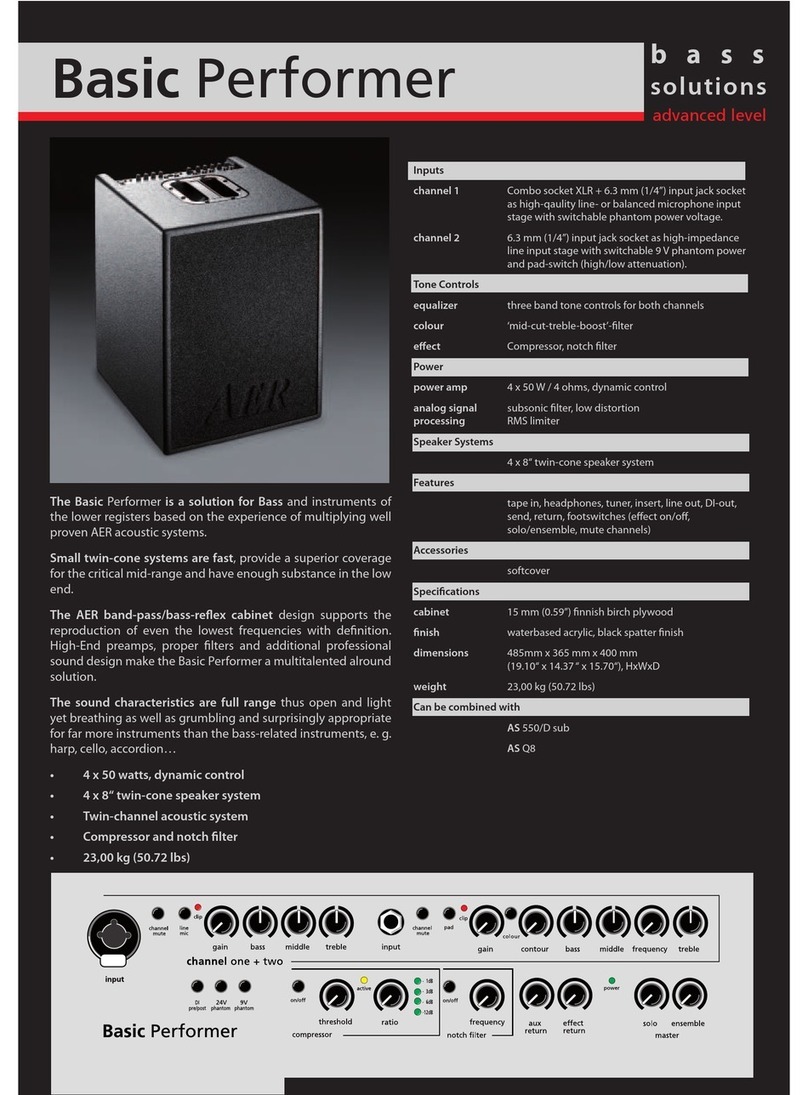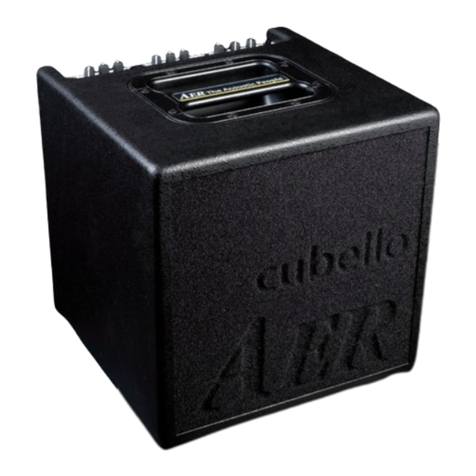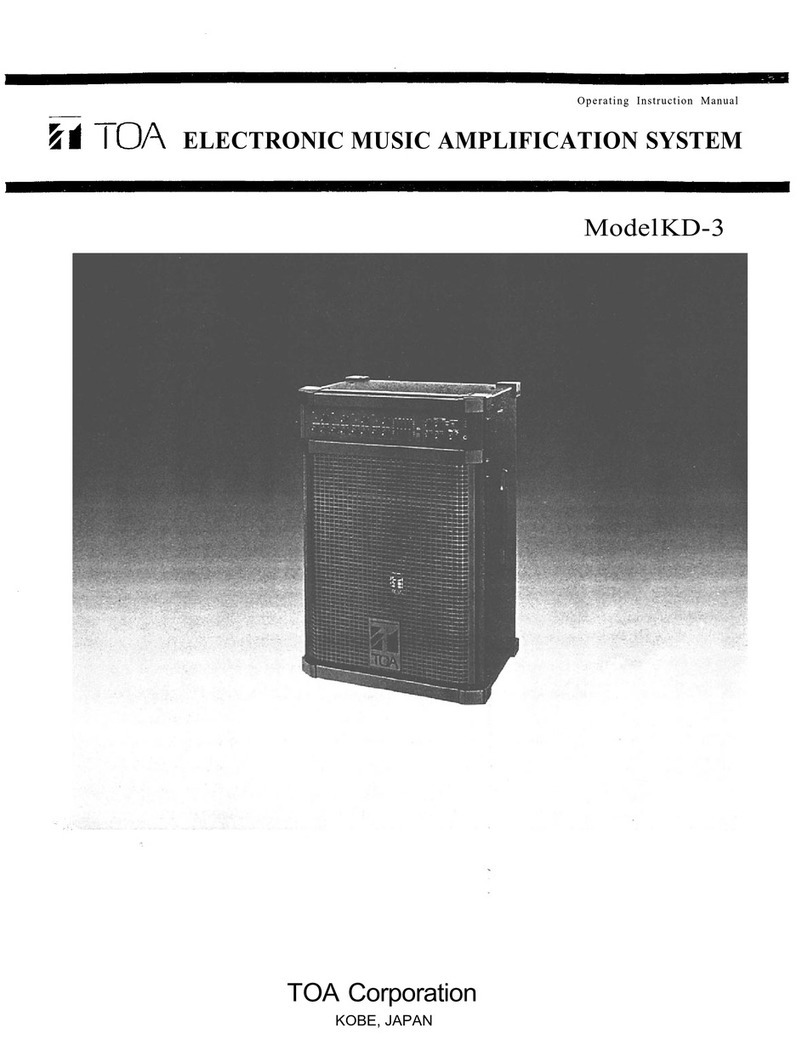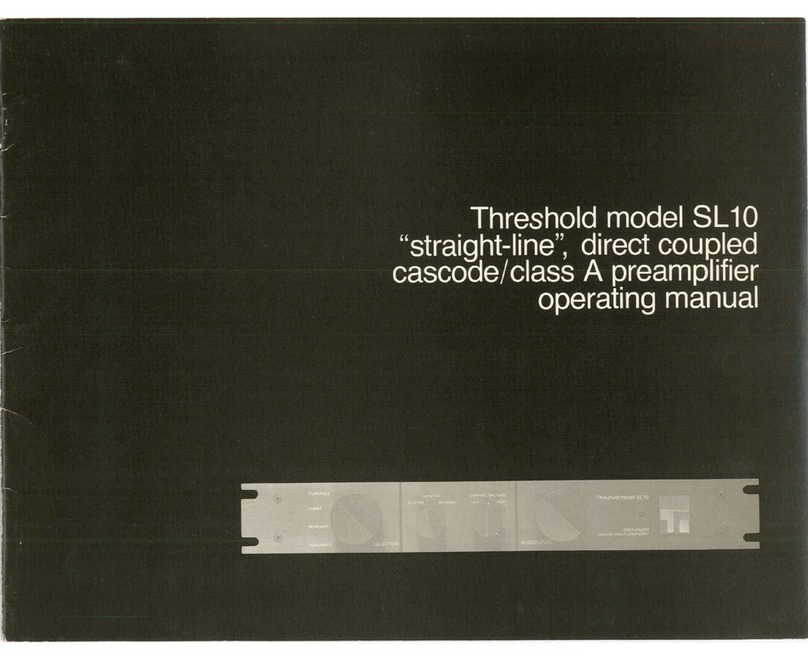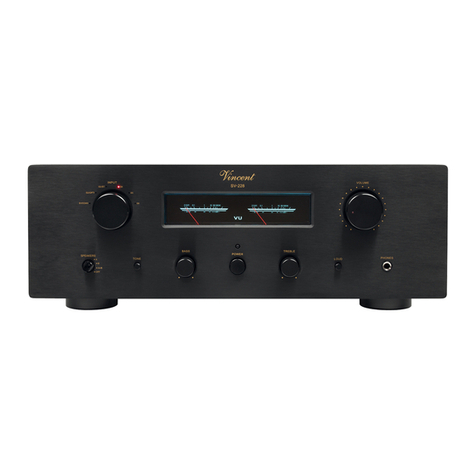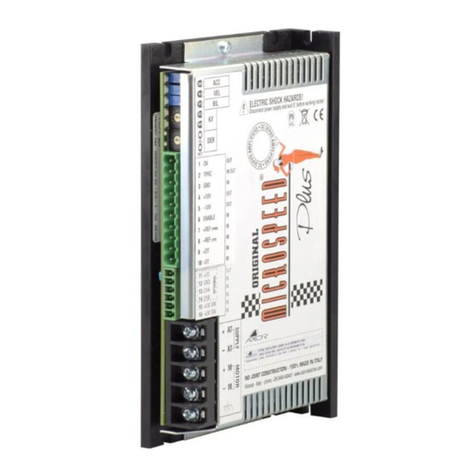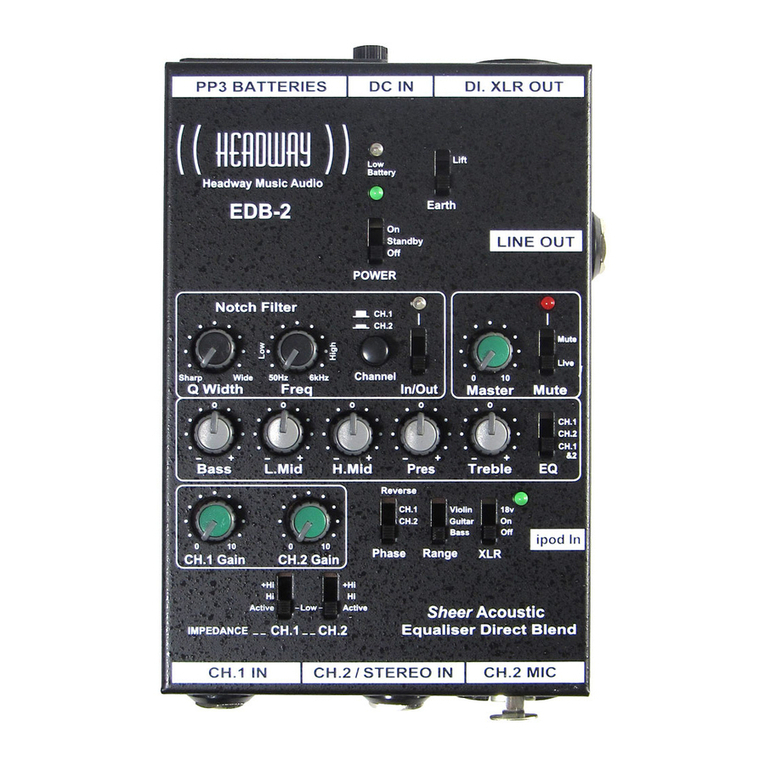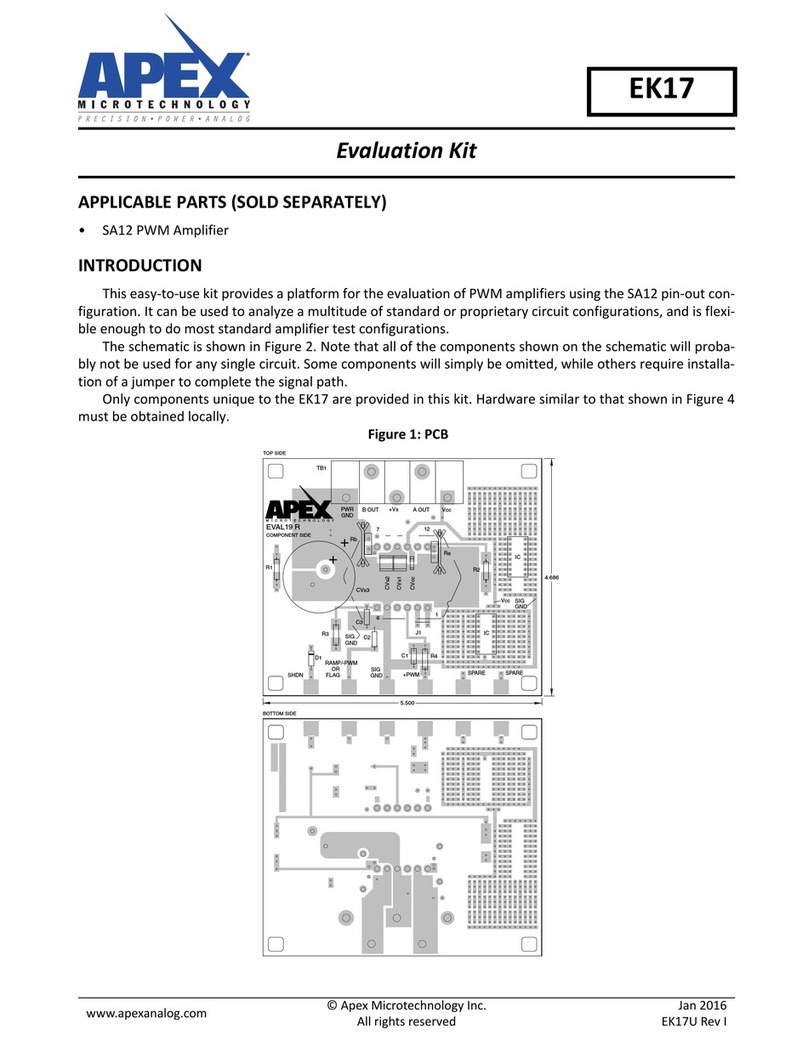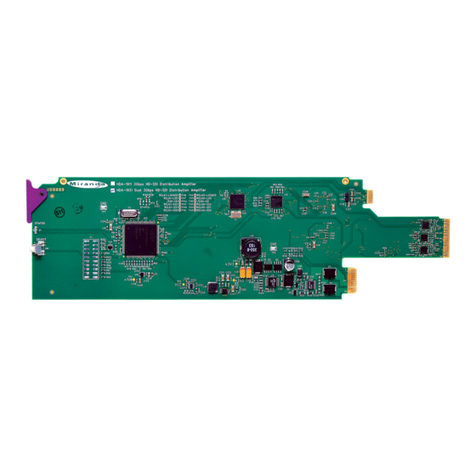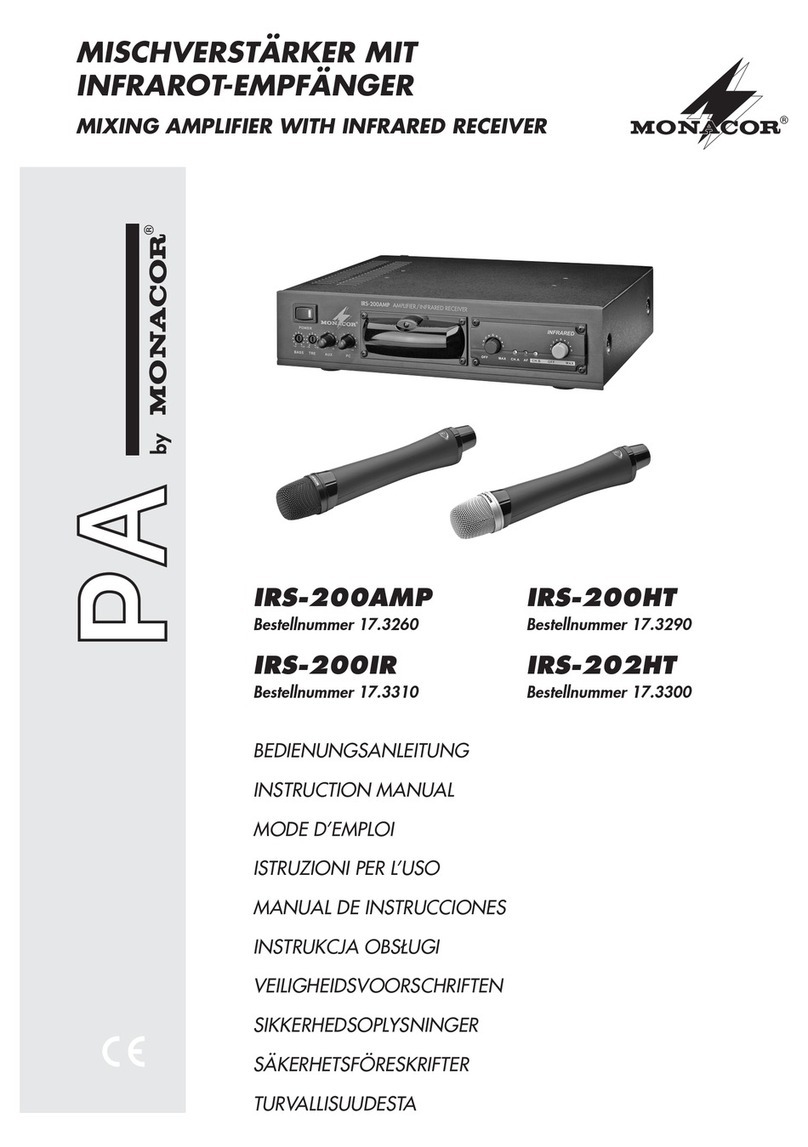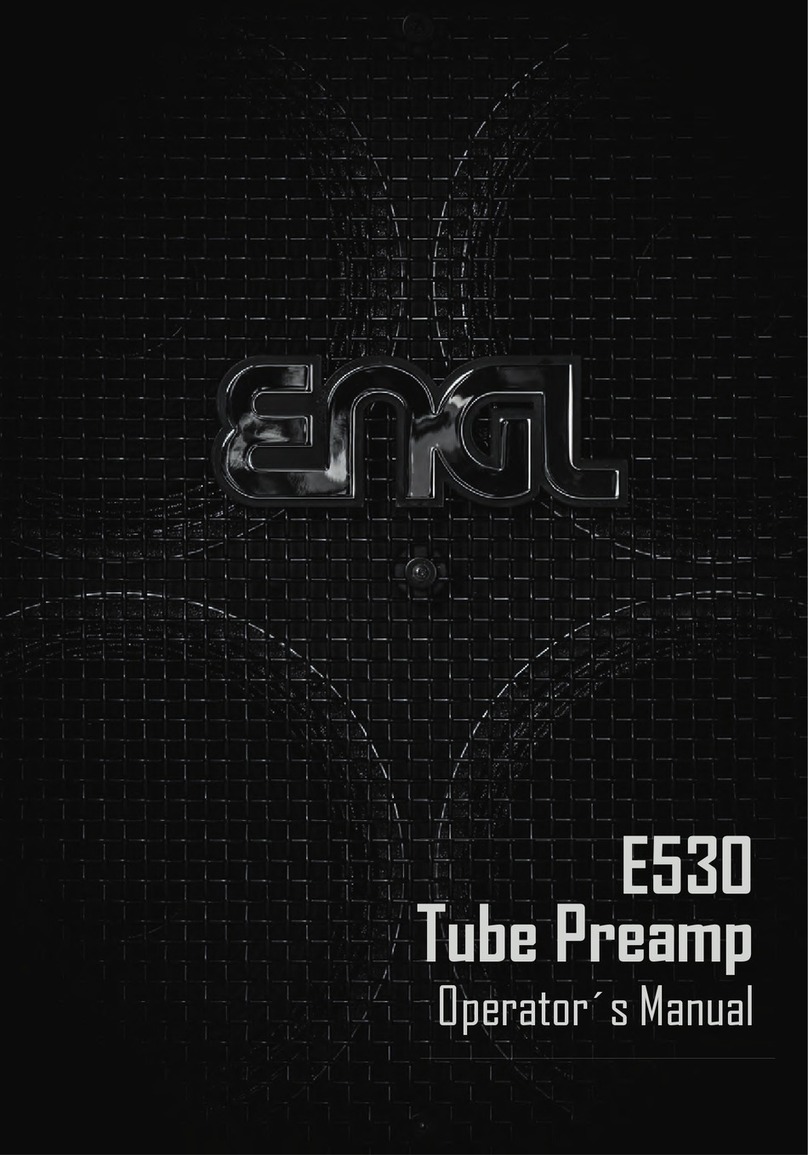AER Domino 2A User manual

1
Domino2.A
user manual

2
Domino2.A
user manual
Contents Page
1. Introduction 3
2. Safety Instructions 4
3. Controls and Connections 5
3.1 Front Side 5
3.2 Rear Side 6
4. Starting up 7
4.1 Cabling and Switching-on 7
4.2 Level Adjustment 7
5. Functional characteristics 8
5.1 Mute 8
5.2 Equalization 8
5.3 Eects 8
5.4 Phantom-Power 9
5.5 Stereo-Simulation 9
5.6 Insert-Loop 10
5.7 Connecting AER-amps via Insert-Loop 11
6. Technical Specications 12
7. Circuit Diagram 14

3
1. Introduction
Welcome to B!
Thank you for purchasing the Domino2.A of our acou-
stic-line-series.
To obtain maximum enjoyment from your amplier
please read this manual carefully before using your
Domino2.A.
Based on our Compact602-acoustic-system we have
developed the Domino2.A a 100-watt system that com-
bines the excellent tone of the Compact with increased
power and higher eciency.
The Domino2.A is – of course – dynamically controlled
and equipped with two parallel power-ampliers, two
8“-twin-cone loudspeakers, 1“-neodym tweeter for ad-
ditional headroom, 4 inputs with mute-option (inputs
3 and 4 with shared equalization), channel mute, in-
sert-link feature and AER-32/24-bit-digital-eects with
16 presets.
Read on and have fun using your Domino2.A!

4
2. Safety Instructions
The following guidelines shall help minimize the risk
of injury through re or electric shock.
1. Carefully read these safety notes before you use
the device!
2. Keep these safety notes in a safe place.
3. Pay attention to all warnings, instructions and ad-
ditional texts on the unit.
4. Do not install or use your device in close proximity
to water or if you are wet yourself.
5. Use your device in a safe place where nobody can
step on cables or trip over and damage them.
6. Always pull the mains plug before cleaning your
device. Use only a dry cloth for cleaning. Avoid the
use of detergents and do not let any liquids seep
into the unit.
7. Never install your device close to units with strong
electromagnetic elds such as large mains transfor-
mers, revolving machines, neon illumination etc. Do
not lay signal cables parallel to power current cables.
8. There are no user-serviceable components inside
the unit. To avoid the risk of an electric shock, the
unit must not be opened. All maintenance, adjust-
ment and repair works should be carried out by
qualied sta only. Any unauthorized tampering will
void the 2-year warranty.
9. In keeping with the EMV regulations screened
cables with correctly tted connectors must be used
for all signal connections.
10. Always use an earthed power supply with the
correct mains voltage. If you are in doubt about the
power outlets ground, have it checked by a qualied
technician.
11. Cable up your device only when it is powered o.

5
3. Controls and Connections
master
channels 1 – 4
eects
3.1 Front Side
1) input signal input, 6,3 mm mono jack socket
2) mute channel mute switch: deactivated active
3) attn. input sensitivity switch – attenuator o on
4) clip overload indicator
5) gain input level control
6) colour tone colour lter activation switch: deactivated active
7) bass bass frequency control
8) middle middle frequency control
9) treble treble frequency control
10) e. send eect level control
11) input signal input – combo socket for 6,3 mm mono jackplug and XLR-male-connector
12) line/mic signal source selector switch of the combo socket:
line (only via jackplug) for instruments (pickup) and other line level sources
mic (only via XLR-connector) for microphones
13) 48V 48V-phantom-power switch for microphone: deactivated active
14) stereo sim. stereo simulation switch: deactivated active
15) select eect select switch
16) return eect return control (internal eect)
17) aux return aux return control
18) eect 2 return eect return control (external eect)
19) pre master level control pre master for L-out, R-out and rec out
20) power on/o-status indicator
21) master master level control
clipattn. colourmute
line/micmute
input
input
input
gain
gain
bass middle treble eff. send
clipline/mic colourmute gain bass middle treble eff. send
clipattn. colourmute
48V stereo sim. power
input gain bass middle treble eff. send
select return aux
return effect 2
return pre
master master
channel one
channel three + four
channel two
effect master
Domino2.A
12
3
4
5
6
7
8
9
10
11
12
13
14
15
16
20120705
clipattn. colourmute
line/micmute
input
input
input
gain
gain
bass middle treble eff. send
clipline/mic colourmute gain bass middle treble eff. send
clipattn. colourmute
48V stereo sim. power
input gain bass middle treble eff. send
select return aux
return effect 2
return pre
master master
channel one
channel three + four
channel two
effect master
Domino2.A
12
3
4
5
6
7
8
9
10
11
12
13
14
15
16
20120705
5
5
55
8
8
8
6
6
6
7
7
7
18 19 21
1
111
13 14 16 17
2
22
2
3
3
9
9
9
4
4
4
12
12
15
10
10
10
20
11

6
1) rec out: stereo output with equalizer, eect,
stereo-reproduction of ext. eect, aux in and ste-
reo simulation (switchable), Cinch/RCA-sockets
(white = left channel, red = right channel)
2) aux in: stereo input for additional signal sour-
ces, e.g. CD-player, Cinch/RCA-sockets (white =
left channel, red = right channel)
3) headphones: stereo-headphones socket
!!!
Warning: Only use
headphones with stereo
jackplugs in this output
socket!!!
4) tuner: tuner output socket (mono, -10 dbV) pre
master
5)/6) L-out/R-out: stereo output with equalizati-
on, eects, stereo-reproduction of external eect,
aux in and stereo-simulation (switchable), 6,3 mm
jack socket
7) insert: insert point, 6,3 mm stereo-jack-plug,
tip = send, ring = return, for serial looping of
eect-devices or for connecting AER-amps with
link-feature. (see para. 5.6, page 10)
3.2 Rear Side
8) line out: signal output e.g. for active louds-
peakers, 6,3 mm mono jackplug, sum signal with
equalization and eects, post master
9) DI-out: signal output, symmetrcal, XLR-fema-
le-socket, without equalization and eects, pre
master
10)/11) ext. eect send/return: loop point with
mono jackplugs for an external eect-device or
other signal sources. return and send together
form an eect loop path. The eect can be swit-
ched on or o by a standard footswitch.
12) footswitch eect on/o: Stereo connector
socket for a double-footswitch (on-/o-switch, tip
= internal eect/ring = external eect on/o).
13)/14) footswitch mute channel 1/2 + 3/4:
Stereo connector socket for a double-footswitch,
mute input 1/2 (tip = input 1, ring = input 2) resp.
mute input 3/4 (tip = input 3, ring = input 4).
15) power on: Combined mains switch with
mains socket and fuse holder. (s. Technical Data
Mains Fuse)
Domino2.A
power on
1 = gnd
2 = pos
3 = neg
return
send
DI-out
headphones tuner L-out R-out insert line-out
effect on/off mute channel 3/4
mute channel 1/2
rec out aux in
ext. effect footswitch
C AUT I ON
RISK OF ELECTRIC SHOCK
DO NOT OPEN
AT T E N T I O N
RISQUE DE CHOC ELECTRIQUE
NE PAS OUVRIR
Made in Germany by B
20120705
1 2 3 4 6 8 11975
13
1412
10
Domino2.A
power on
1 = gnd
2 = pos
3 = neg
return
send
DI-out
headphones tuner L-out R-out insert line-out
effect on/off mute channel 3/4
mute channel 1/2
rec out aux in
ext. effect footswitch
C AUT I ON
RISK OF ELECTRIC SHOCK
DO NOT OPEN
AT T E N T I O N
RISQUE DE CHOC ELECTRIQUE
NE PAS OUVRIR
Made in Germany by B
20120705
15
20120705

7
The clip-LED indicates an overload. A short icker is
of no danger to AER devices. During operation a short
icker can be accepted, to be on the safe side you
should reduce the gain slightly to achieve an optimal
and distortion-free performance.
Please bear in mind: The Domino2.A is equipped with
four inputs. Four individual gain-levels may boost the
input-signal of the eect-section and thus cause dis-
tortion. This distortion can only be heard and in this
case it is imperative, to reduce the gains to elminitate
the distortion.
With the line/mic-switch you can adjust your ampli-
er to your signal-sources (guitar pickup, micropho-
ne etc.). The attn.-switch (attenuator de-/activation),
as well as gain-control and line/mic-switch, helps
with the signal-matching. Start without attenuator
(switch not pressed). Should the input-signal be too
strong and you can’t avoid clipping even by redu-
cing the gain-control, then activate the attenuator
(switch pressed).
Finally set the desired overall volume level with the
master level control.
4. Starting up
4.1 Cabling and switching on
Before connecting to mains, please ensure that your
local mains voltage is suitable for the voltage of the
device (e.g. 120V in the
USA, 230V in Europe).
The relevant specs and
safety symbols are prin-
ted on the rear side of
the unit.
Connect all cables according to your application and
switch the amplier on. The green power control LED
indicates operational readiness.
4.2 Level Adjustment
Note: Level adjustment
By setting the level correctly we mean the signal level
in one or several devices in a signal chain is neither
too high nor too low. This applies equally to all cir-
cuits in a complete circuit design (EQs, preamps etc.)
Consequently, care must be taken that no part of the
circuit is overloaded or that distortion is unintentio-
nally added to the signal.
We have carefully designed the circuit to achieve this
objective whilst also providing controls for „manual“
intervention.
First ensure, that the master level control is zeroed
(over to far left), so that when you are setting the
sound level, the signal passes through the electronics
only and does not reach the loudspeaker. By pressing
the high-/low- (attn.) resp. line-/mic-switches you
can adapt the amplier to your signal sources (guitar
pickups, microphone etc).
Turn the gain control clockwise until the red clip indi-
cator ashes momentarily when playing with a strong
attack. Thus you make sure that your signal source
(e.g. instrument) provides the input-stage of the am-
plier with the necessary input.
clipattn. colourmute
line/micmute
input input
input
gain
gain
bass middle treble eff. send clipline/mic colourmute gain bass middle treble eff. send
clipattn.
colour
mute
48V stereo sim. power
input gain
bass middle treble eff. send select return aux
return effect 2
return pre
master master
channel one
channel three + four
channel two
effect master
Domino2.A
12
3
4
5
6
7
8
9
10
11
12
13
14
15
16
20120705

8
5. Functional characteristics
5.1 Mute
The mute switch turns the appliance to mute as requi-
red. The function can also be activated by a standard
footswitch (on/o switch).
5.2 Equalization
The triple-band equalizer of your Domino2.A provides
you with an active and high quality sound interaction
tool that supports the natural tone of instruments and
voice whilst simultaneously oering you the possibili-
ty of a controlled accentuation.
With all controls in mid position the lters are set to
produce a very pleasing and natural sound impression
that you can„colour up“ by using the colour lter with
the eect of lowering the mids and lifting the trebles
(-3 dB at 700 Hz, +10 dB at 8kHz). The tone becomes
more open and light and is especially suited for nger-
picking techniques.
The equalization can support or soften the eect of
the colour lter and allows a dierentiated mids-ac-
centuation.
A: with colour-lter (switch pressed)
reduce treble to soften possible sharpness
B: without colour-lter (switch not pressed)
boost treble to brighten the sound
colour bass middle treble
colour bass middle treble
Note:
The active equalization of the Domino2.A eects the
signal adjustment. If you spot an intensied ickering
of the clip indicator, level the signal level with the gain
control (s. 4.2 Level adjustment).
5.3 Eects
The Domino2.A has a built-in (internal) digital
32/24-bit-AER-eect processor, with the select-switch
you can choose between 16 diverging presets (s.
chart below).
The return-control determines the intensity of the
internal eects (left stop = no eect), the e. send-
controls level the ratio of eect and original signal
per channel.
Progr.-No. Description
1 ambience: short
2 ambience: medium
3 ambience: long
4 reverb: short
5 reverb: medium-short
6 reverb: medium
7 reverb: long
8 reverb: very long
9 delay: 100ms
10 delay: 320ms short
11 delay: 320ms long
12 chorus
13 delay (410ms) with reverb-portion short
14 reverb with delay-portion (410ms) long
15 chorus with reverb-portion
16 reverb with chorus-portion
Furthermore an additional eects unit (external ef-
fect) may be connected to the Domino2.A. For this
purpose use the send and return sockets on the rear
side of the amplier (send goes to input, return to
the output of the external eects device). The inten-
sity of the eect is adjusted at the external eects
unit.

9
5.4 Phantom power
Microphones requiring 48V phantom power can be
directly connected to the XLR sockets of channels 2
and 3/4. The phantom power can be switched on and
o via the 48V-switch.
The jack sockets of channel 1 and 3/4 can additio-
nally be supplied 15V-Phantomspeisung by an in-
ternal jumper.
Please note: For these alterations the device must
be opened, therefore only qualied service person-
nel may carry out the modications concerning the
activation of phantom power.
5.5 Stereo-Simulation
The Domino2.A is mono – thus L-out and R-out are
carrying the same output-signal. You can use these
sockets to connect additional active AER fullrange-
systems (e.g. AG 82, CX 8, AS Q8, AS 281), whose levels
are adjusted by the pre master-control independent
of the overall volume (master) of your Domino2.A. By
activating the stereo-simulation (stereo sim.-switch
pressed), a stereo-like, wider sound impression is ge-
nerated.
On stage (Domino2.A as monitor) the sound remains
unchanged..
General Note: Use of 48V or 24V phantom
power
(Phantom power = remote supply, here: powering
an audio device via the connected audio line)
Turn on the phantom power only if the unit con-
nected to the XLR sockets of channels 2 and 3/4 is
designed to handle it!
In general, suitable units are e.g. condenser micro-
phones, active DI-boxes and other special audio
devices, whose power supply is drawn from the
phantom power. Such devices are also labelled ac-
cordingly; please heed the permissible power con-
sumption (max.10mA).
High-quality dynamic microphones with a balanced
signal need no phantom power, but can handle it
anyway.
Other devices, which have not been designed expli-
citly for phantom power operation, can suer from
considerable malfunctions and damage may result
as well.
Examples of devices that may be damaged by in-
correct application of phantom power include:
Low-cost dynamic microphones with a mono jack-
plug (unbalanced signal) that were tted afterwards
with an XLR connector.
Audio devices with a balanced XLR output (e.g. DI-
boxes, eects devices, instrument preamps with
a DI output etc.) which are not protected against
phantom power applied to their XLR output. (The
DI connectors on AER products are protected
against applied phantom power.)
Other audio devices (such as preamps, eects pe-
dals etc.) whose unbalanced line output was repla-
ced by an XLR socket.
If in doubt please consult the manufacturer of the
device you are using.

10
5.6 Insert
The insert-loop is an in-/output on a stereo-socket to link dierent eect-de-
vices (EQ, compressor etc.) in serial mode with tip = send (input) and ring =
return (output). This conguration allows several more applications, such as:
1. use as additional line-output
2. use as additional line-input
3. link between two or more AER-amps with insert-feature (AG8, Domino,
Compact ClassicPro)
For each of these applications you’ll need the appropriate cable connection,
e.g. use as line-output: stereo-jack (tip and ring = hot, sleeve = ground) to
mono-jack.
The particular AER-link-application (s. no. 3 - link between AER-amps) is re-
presented on page 11. In link-operation it is assured, that the signals of all con-
nected amps are hearable on all devices, even with dierent eect settings.
You just have to be aware, that the dierent levels depend on each other.
This setting (in combination with active loudspeakers, pre master-function)
works as a complete and easily operated reinforcement/monitor system.

11
L-out R-out
tip
tip
tip
ring
ring
tip
tip
tip
ring
ring
insert
insert
line out
return
line out
return
send
external eect
In case of occupied return-socket due to insert operation, you can still
loop an external effect using the send-and aux-in-sockets.
Domino2.A
power on
1 = gnd
2 = pos
3 = neg
return
send
DI-out
headphones tuner L-out R-out insert line-out
effect on/off mute channel 3/4
mute channel 1/2
rec out
aux in
ext. effect footswitch
C A UT IO N
RISK OF ELECTRIC SHOCK
DO NOT OPEN
AT T E N T I O N
RISQUE DE CHOC ELECTRIQUE
NE PAS OUVRIR
Made in Germany by B
20120705
clipattn. colourmute
line/micmute
input input
input
gain
gain
bass middle treble eff. send clipline/mic colourmute gain bass middle treble eff. send
clipattn. colourmute 48V stereo sim. power
input gain bass middle treble eff. send select return aux
return effect 2
return
pre
master
master
channel one
channel three + four
channel two
effect master
Domino2.A
12
3
4
5
6
7
8
9
10
11
12
13
14
15
16
20120705
5.7 Example for the linking of AER-amps via the insert connection
PA-System PA-System

12
6. Technical Specications Domino2.A, page 1
Domino2.A - 2012_07_GB
Technical data
Inputs
High impedance, unbalanced instrument or
line inputs
Mono jack socket, ¼“ (6.35 mm)
Min. input voltage: 21 mV (–34 dBV)
Max. input voltage: 4 V (+12 dBV)
Input impedance: 2.2 M|| 150 pF
Equivalent input noise voltage (A-weighted):
1.7 μV (–115 dBV)
Attenuator switch: –10 dB
Phantom power: Optional, see notes.
channel one,
channel four
clip indicator
Headroom: min. 6 dB
Switchable line / microphone inputs
Combo socket, XLR + jack ¼” (6.35 mm)
line mode (via jack input only)
High impedance, unbalanced instrument or
line input
Min. input voltage: 25 mV (–32 dBV)
Max. input voltage: 2.8 V (+8 dBV)
Input impedance: 1 M|| 200 pF
Equivalent input noise voltage (A-weighted):
2.6 μV (–112 dBV)
mic mode
Microphone input, XLR (balanced), stereo
jack (balanced), or mono jack (unbalanced)
1 / sleeve = ground,
2 / tip = positive (+),
3 / ring = negative (–)
Min. input voltage: 2 mV (–55 dBV)
Max. input voltage: 250 mV (–12 dBV)
Input impedance (balanced): 1.1 k
Input impedance (unbalanced): 4 k
Voice filter:
–10 dB at 270 Hz referred to 10 kHz
Equivalent input noise voltage (A-weighted):
2.4 μV (–112 dBV)
Phantom power: 48 V, XLR only, switchable,
R = 6.8 kper terminal, max. 10 mA per
input, short-circuit protected.
channel
two,
channel
three
clip indicator
Headroom: min. 6 dB
aux in Auxiliary stereo input, e.g. for CD player
Cinch (RCA) sockets, L / R
Level adjustable by aux return
Min. input voltage: 125 mV (–18 dBV)
Max. input voltage: 10 V (+20 dBV)
Input impedance: min. 3.7 k
(varies with level setting)
ext. effect
return
Input from external parallel effect loop, or
supplementary input
Mono jack, ¼” (6.35 mm)
Level adjustable by effect 2 return
Min. input voltage: 410 mV (–9 dBV)
Max. input voltage: 10 V (+20 dBV)
Input impedance: min. 8 k
(varies with level and footswitch setting)
Outputs
rec out Stereo line output
Cinch (RCA) sockets, L / R
For more specs see L-out, R-out
headphones Stereo headphones output
Stereo jack socket, ¼” (6.35 mm)
When plugged in, internal speakers are
muted.
Output power at rated conditions:
2 x 24 mW / 32
Max. output power: 2 x 160 mW / 16
Min. load impedance: 8
Caution:
Suitable for stereo headphones
only. Connecting a mono jack or
connecting to other devices may cause
malfunction or damage.
tuner Tuner output, before tone controls and
effects, not affected by mute
Mono jack, ¼” (6.35 mm)
Output voltage: 330 mV (–10 dBV)
Output impedance: 47
Min. load impedance: 2 k
L-out, R-out Stereo line output after tone controls,
adjustable by pre master, with switchable
stereo simulation, aux in, and effects
2 mono jack sockets, ¼” (6.35 mm), L / R
Output voltage: 0…1 V (0 dBV),
adjustable by pre master
Output impedance: max. 15 k
(varies with level setting)
Min. load impedance: 2 k
Residual noise (A-weighted):
< 1 μV (–120 dBV)
line out Mono line output after master, with aux in
and effects, and after insert
Mono jack, ¼” (6.35 mm)
Output voltage: 460 mV (–7 dBV)
Output impedance: 100 (but depends on
external device if insert is also used)
Min. load impedance: 2 k
Residual noise (A-weighted):
4.5 μV (–107 dBV)
DI-out Balanced, non-isolated XLR output, before
tone controls, with aux in, without effects
1 = ground,
2 = positive (+),
3 = negative (–)
Output voltage (differential):
68 mV (–23 dBV)
Output impedance: 100 , each terminal to
ground
Min. load impedance (differential): 1 k
ext. effect
send
Output for external parallel effect loop,
before master, after tone controls
Independent on send controls (see notes)
Mono jack, ¼” (6.35 mm)
Output voltage: 1 V (0 dBV)
Min. load impedance: 2 k
Insert connector
insert Connector for serial insert loop, after master
but before line out.
Interrupts the direct signal path when used.
Stereo jack, ¼” (6.35 mm),
tip = send, ring = return
Output and input voltage: 460 mV (–7 dBV)
Output impedance (send): 47
Min. load impedance (send): 2 k
Input impedance (return): 22 k(but
depends on external device if line out is
also used)
Footswitch connectors
footswitch
effect int/ext
Connector for a dual footwitch
Stereo jack, ¼” (6.35 mm)
Tip = internal effect on/off
Ring = external effect on/off
Sleeve = common (ground)
Function: Switch ON = effect muted
footswitch
mute ch 1/2,
footswitch
mute ch 3/4
Connectors for dual footwitches
Stereo jack, ¼” (6.35 mm)
Tip = muting ch. 1 (3)
Ring = muting ch. 2 (4)
Sleeve = common (ground)
Function: Switch ON = channel muted
When plugged in, the respective mute
buttons of the amp are disabled.

13
6. Technical Specications Domino2.A, page 2
Domino2.A - 2012_07_GB
Tone controls
Note: Channels 3 and 4 share the same tone controls.
colour –3 dB at 700 Hz
+10 dB at 8 kHz
bass 8 dB at 100 Hz (shelf type)
middle 6 dB at 800 Hz
All channels
treble 8 dB at 10 kHz (shelf type)
Effects
Built-in
effect
Digital effect processor with 16 presets.
Contribution from channels 1, 2, and 3+4 is
adjustable by send controls.
External
effects
See ext. effect send, ext. effect return,
and insert
Stereo
simulator
Switchable, effective on L-/R-out and rec out
but not headphones
Power
Power amp 2 x 60 W / 4 (1% THD)
DMOS, monolithic I.C.
Dynamic range (A-weighted): 93 dB
Limiter
threshold
2 x 50 W / 4
Mains power Mains voltage (depending on model):
100, 120, 230, or 240 V AC, 50–60 Hz
Power consumption: max. 250 W
Mains fuse Size: 5 x 20 mm
For 230 and 240 V models: T 1.6 A L / 250 V
For 100 and 120 V models: T 3.15 A L / 250 V
General
Distortion THD+N < 0.1% at 2 x 6 W / 4
Analog signal
processing
Subsonic filter, adaptive peak limiter
Speaker
system
Two 8” (200 mm) dual cone full-range
speakers,
1” (25 mm) neodymium dome tweeter,
bass reflex enclosure
Cabinet 12 mm (0.47“) birch plywood
Finish Waterbased acrylic, black spatter finish
Dimensions 360 mm (14.2“) high
415 mm (16.3“) wide
290 mm (11.4“) deep
Weight 12.8 kg (28.2 lbs)
NOTES
Rated conditions:
Input 50 mV rms / 1 kHz at channel one.
Gain of channel one fully clockwise.
All tone controls in center position, colour off.
Master adjusted such that the rated output power (limiter
disabled) or, alternatively, the rated output voltage at line
out is obtained.
Output voltages refer to rated conditions as stated above.
Min. input voltage: Input voltage required for rated output
power (limiter disabled) with gain and master fully
clockwise
Max. input voltage: Input voltage that does not cause more
than 1% THD+N, suitable control settings provided
THD+N: Total harmonic distortion + noise at input and
output levels 10 dB below rated conditions.
Equivalent input noise voltage: Noise voltage at speaker
output divided by gain of amplifier. gain of input under
test fully clockwise, master fully clockwise, gain of unused
inputs minimal. Input shorted, B = 22 Hz … 22 kHz
Residual noise: Noise of an output when its level control is
set to minimum.
Dynamic range (power amp): Ratio of rated output voltage
to residual noise voltage with master fully anticlockwise.
Options: The following options are available by internal
jumper settings.
1) Channels 1 and 4 can have 15 V phantom power
enabled at “ring” of jack socket.
Caution: This option is
not overload-protected. Improper use may cause
malfunction or damage.
2) Gain of channels 2 and 3 can be reduced by 3 dB to
allow for more headroom.
3) Ext. effect send level can be made dependent on the
send controls of each channel.
4) Internal effect can be disabled for each channel.
5) Aux input signal can be disconnected from DI out.
6) Internal effect can be added to DI out.
Specifications and appearance subject to change without
notice.
TD20120709

14
7. Circuit Diagram Domino2.A, page 1
B120508A_20120627
LINE
MIC
MIC
LINE
LINE
MIC
MIC
LINE
AUX IN (CINCH)
REC OUT (CINCH)
SPEAKER MUTE
PREAMP
Optional +15V
ATTENUATO R
GAIN COLOUR MIDDLE
OFF/ON
SUBSONIC LIMITER POWER AMP 200mm (8") DUAL CONE
TREBLEBASS
+48V (switchable)
PREAMP VOICE
6k8
6k8
INPUT
PREAMP
MUTE
INPUT
HIGH/LOW
GAIN COLOUR MIDDLE
OFF/ON
TREBLEBASS
MUTE
INPUT BUFFER
CLIP DETECTION CLIP DETECTION
CLIP DETECTION
CLIP DETECTION
+48V (switchable)
PREAMP VOICE
6k8
6k8
INPUT 3
PREAMP
HIGH/LOW
GAIN
CLIP DETECTION
MUTE
Optional +15V GAIN MUTE
INPUT 4
INPUT BUFFER
CLIP DETECTION
COLOUR MIDDLE
OFF/ON
TREBLEBASS
CLIP DETECTION
EFF. SEND
EFF. SEND
EFF. SEND
MUTE
PREAMP
ATTENUATO R
MUTE
MUTE
MUTE
TUNER
EXT. EFF. SEND
CH1
CH2
CH3/4
SEND1
SEND2
SEND3/4
SEND1
SEND2
SEND3/4
DSP EFFECTS UNIT
SELECT
L
R
DI out
AUX
POST/PRE EQ
POST/PRE EQ
POST/PRE EQ
INT. EFFECT
AUX RETURN
RETURN
EXT. EFF. RETURN
STEREO SIM
STEREO SIM.
EFFECT 2 RETURN
FOOTSWITCH EFFECT INT./EXT.
PRE MASTER
L-OUT
R-OUT
L
R
MASTER
HEADPHONES
INSERT
LINE OUT
POWER AMP 200mm (8") DUAL CONE
FOOTSWITCH MUTE CH1/CH2
FOOTSWITCH MUTE CH3/CH4
25mm (1") DOME TWEETER
CHANNEL 1
CHANNEL 2
CHANNEL 3/4
1
2
3
TR
TR
1
2
3
TR
TR
1
2
3
TR TR
TR
SRT
T R
TR
TR
www.aer-amps.com
Domino2.A - 2012_07_GB

15
7. Circuit Diagram Domino2.A, page 2
B120508A_20120627
LINE
MIC
MIC
LINE
LINE
MIC
MIC
LINE
AUX IN (CINCH)
REC OUT (CINCH)
SPEAKER MUTE
PREAMP
Optional +15V
ATTENUATO R
GAIN
COLOUR MIDDLE
OFF/ON
SUBSONIC LIMITER POWER AMP 200mm (8") DUAL CONE
TREBLEBASS
+48V (switchable)
PREAMP VOICE
6k8
6k8
INPUT
PREAMP
MUTE
INPUT
HIGH/LOW
GAIN
COLOUR MIDDLE
OFF/ON
TREBLEBASS
MUTE
INPUT BUFFER
CLIP DETECTION
CLIP DETECTION
CLIP DETECTION
CLIP DETECTION
+48V (switchable)
PREAMP VOICE
6k8
6k8
INPUT 3
PREAMP
HIGH/LOW
GAIN
CLIP DETECTION
MUTE
Optional +15V GAIN MUTE
INPUT 4
INPUT BUFFER
CLIP DETECTION
COLOUR MIDDLE
OFF/ON
TREBLEBASS
CLIP DETECTION
EFF. SEND
EFF. SEND
EFF. SEND
MUTE
PREAMP
ATTENUATO R
MUTE
MUTE
MUTE
TUNER
EXT. EFF. SEND
CH1
CH2
CH3/4
SEND1
SEND2
SEND3/4
SEND1
SEND2
SEND3/4
DSP EFFECTS UNIT
SELECT
L
R
DI out
AUX
POST/PRE EQ
POST/PRE EQ
POST/PRE EQ
INT. EFFECT
AUX RETURN
RETURN
EXT. EFF. RETURN
STEREO SIM
STEREO SIM.
EFFECT 2 RETURN
FOOTSWITCH EFFECT INT./EXT.
PRE MASTER
L-OUT
R-OUT
L
R
MASTER
HEADPHONES
INSERT
LINE OUT
POWER AMP 200mm (8") DUAL CONE
FOOTSWITCH MUTE CH1/CH2
FOOTSWITCH MUTE CH3/CH4
25mm (1") DOME TWEETER
CHANNEL 1
CHANNEL 2
CHANNEL 3/4
1
2
3
TR
TR
1
2
3
TR
TR
1
2
3
TR TR
TR
SRT
T R
TR
TR
www.aer-amps.com
Domino2.A - 2012_07_GB

www.aer-amps.com
Domino2.A - 2012_07_GB
Other manuals for Domino 2A
2
Table of contents
Other AER Amplifier manuals

